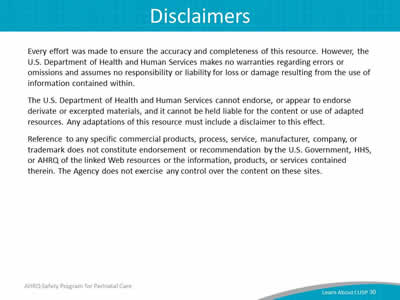Learn About the Comprehensive Unit-based Safety Program for Perinatal Safety: Facilitator Guide
AHRQ Safety Program for Perinatal Care
Slide 1: Learn About the Comprehensive Unit-based Safety Program for Perinatal Safety

Say:
This module introduces the comprehensive unit-based safety program, also called CUSP, that we will use as the foundation of the Safety Program for Perinatal Care. It includes training tools to make care safer by improving the foundation of how your physicians, nurse-midwives, staff nurses, and other clinical team members work together on the labor and delivery unit.
Slide 2: CUSP and Perinatal Safety

Say:
Before we begin, it's important to point out that improving perinatal safety involves efforts on multiple fronts, including the labor and delivery, or L&D, units, the newborn nursery and neonatal intensive care unit, antenatal and postpartum units, ambulatory medical and obstetric practices, and the community. The principles of CUSP can be applied in any hospital unit; however, the Safety Program for Perinatal care has been tailored for presentation and use specifically in L&D units.
Slide 3: Learning Objectives

Say:
This first module offers an outline and brief history of the CUSP approach to improving patient safety. In this module, we will—
- Show how CUSP supports other perinatal quality and safety tools.
- Outline the Safety Program for Perinatal Care modules designed for this program.
- Identify challenges to applying the Safety Program for Perinatal Care.
- Provide an overview of CUSP results.
Slide 4: Is Your Hospital Safe?

Say:
Is your hospital safe? How would you answer these questions?
Would you want a loved one to be a patient at your hospital? In your unit?
Would you want to be a patient in the unit where you work?
Can you say with 100 percent certainty that you believe your hospital does everything it can to protect its patients?
Slide 5: Safety Program for Perinatal Care

Say:
Built on the foundation of TeamSTEPPS® training, the AHRQ Safety Program for Perinatal Care or SPPC is built around three program pillars:
- Foster a culture of teamwork and communication.
- Implement perinatal safety bundles.
- Establish a program of in situ simulations.
The first program pillar provides general principles and approaches to fostering unit-based approaches for patient safety related to teamwork and communication. CUSP is the framework for this program pillar.
Slide 6: SPPC CUSP Modules

Say:
In addition to this Learn About CUSP module, the first program pillar includes the following modules:
- Assemble the Team/Engage Leadership.
- Understand the Science of Safety.
- Sensemaking and Learn From Defects.
- Implement Teamwork and Communication.
- Engage Patients and Families.
The second and third program pillars provide an opportunity to apply CUSP principles and practices by implementing one or more of the SPPC perinatal safety bundles and establishing a program of in situ simulations.
Slide 7: CUSP Aligns With and Supports Other Quality and Safety Tools

Say:
CUSP aligns with and supports a wide range of safety tools and approaches. When teams experience fatigue with the barrage of improvement projects, team leaders should remember to unify and streamline those initiatives by using the language of a change management framework, such as the Kotter model, to be discussed later. Through the lens of the Kotter model, CUSP aligns with culture change and quality improvement models in the field such as—
- TeamSTEPPS®.
- Six Sigma.
- The Institute for Healthcare Improvement Model for Improvement.
- Plan-Do-Study-Act, or PSDA Cycles.
- Root Cause Analysis.
- Failure Mode Effect Analysis.
- Just Culture.
Slide 8: The CUSP Model

Say:
The CUSP model was originally developed with funding from the Agency for Healthcare Research and Quality, or AHRQ, a national innovator in patient safety. CUSP is a free resource that dovetails with and supports a range of quality and safety improvement models.
Support from the top is crucial to the success of culture improvement efforts, but real, lasting change happens one unit at a time. Improving culture within the health care setting requires the culture model to be based on the understanding that all culture is local and that work to reform culture must be owned at the unit level. The CUSP framework accomplishes this through stressing the fact that patient harm is not an acceptable cost of doing business. Additionally, CUSP is unique in that it can be applied by anyone, anywhere, in any unit, at any time.
Slide 9: A Collaborative Effort

Say:
The CUSP model imparts support for collaboration among providers. The earliest developments and applications of CUSP were collaborative efforts.
Teams at the Johns Hopkins Quality and Safety Research Group developed the CUSP model with AHRQ funding. Patient safety pioneers recognized early that communication and culture were key to creating safer, error-free systems. These pioneers borrowed from other high-reliability fields, like nuclear power and commercial aviation, where the use of checklists and guided communication tools were effective in reducing lapses in team functioning, errors, and the likelihood of harm.
An infection reduction project of the Michigan Health and Hospital Association Keystone Center for Patient Safety demonstrated that CUSP was successful in improving the safety culture.
The toolkit is not meant to replace other safety improvement models, but to support, combine with, and work in tandem with them. While these models vary in their areas of emphasis, they all align when they are viewed through the lens of an organizational change framework such as the Kotter model.
In 2009, more than 350 hospitals in 22 States reduced CLABSI rates by an average of 35 percent. All these units implemented CUSP, and many of them continue to see these rates at or near zero over extended time.
Slide 10: CUSP Supports Kotter's Eight Steps of Change

Say:
The CUSP model supports all eight steps of the popular change model by John Kotter. The first four are—
Step 1: Create a sense of urgency.
Step 2: Create a guiding coalition.
Step 3: Develop a shared vision, and
Step 4: Communicate that vision.
How do you accomplish each of these?
Aligning Kotter's change model with CUSP, the "Understand the Science of Safety" module helps you build the sense of urgency essential to inspire change among your teams. The "Assemble the Team/Engage Leadership" module gives you templates and resources for establishing a guiding coalition to support change. "Identify Defects Through Sensemaking" helps you develop a shared vision among teams. You can communicate the concept using the tools in the "Understand the Science of Safety" and "Identify Defects Through Sensemaking" modules.
Slide 11: CUSP Supports Kotter's Eight Steps of Change

Say:
Steps five through eight of the Kotter model are—
Step 5: Empower others to act.
Step 6: Generate short-term wins.
Step 7: Consolidate gains and produce more change, and
Step 8: Anchor new approaches in culture.
The CUSP Toolkit coincides with Kotter's steps. How can you empower others to take action? Use the tools in the CUSP Toolkit "Assemble the Team/Engage Leadership," "Identify Defects Through Sensemaking," "Implement Teamwork and Communication," and "Understand the Science of Safety" modules.
Slide 12: Introduction to Just Culture Principles
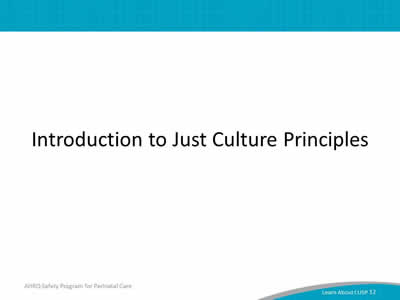
Say:
The term "Just Culture" refers to a safety-supportive system of shared accountability in which health care institutions are accountable for the practices they have designed and for sustaining the safe choices they have made regarding patients, visitors, and staff. Staff, in turn, are accountable for the quality of the choices they make to ensure their patients receive the highest quality of care possible.
Slide 13: Understand Just Culture
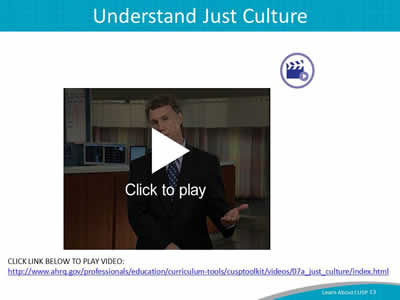
Do:
Play the video.
Ask:
- How would you describe Just Culture to someone?
- Can you identify examples of human error in your unit or hospital? How were these human errors handled?
URL link to video:
Slide 14: Just Culture
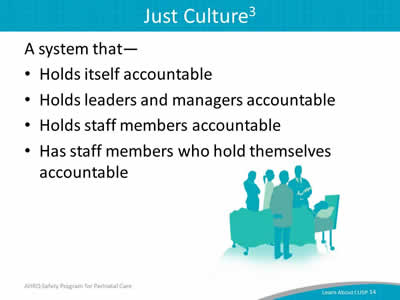
Say:
A Just Culture environment allows the review of both system design and an employee's choice of behavior in response to assigned duties. A Just Culture provides a comprehensive process to investigate events or patient safety concerns and determine an appropriate course of action with the employees involved.
Just Culture principles are a crucial accompaniment to the perinatal CUSP framework and will spark the shared accountability necessary for perinatal CUSP implementation to be successful.
In short, a Just Culture is a system that holds itself accountable, holds leaders and managers accountable, holds staff members accountable, and has staff members who hold themselves accountable.
In a Just Culture, shared responsibility is the norm, and a commitment to eliminating the possibility of error is widespread within a Just Culture.
Slide 15: Understanding Risk and Human Behavior
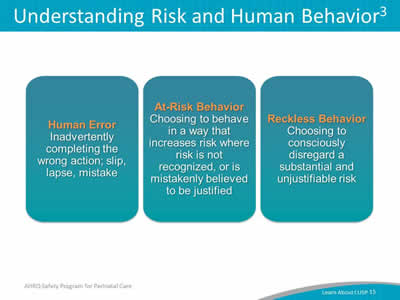
Say:
The concept of Just Culture gives a framework for understanding risk and human behavior. There is a continuum of possible attitudes and behaviors related to risk, and this continuum is described in three categories:
- Human error—Inadvertently completing the wrong action; a slip, a lapse, or mistake.
- At-risk behavior—Choosing to behave in a way that increases risk, where risk is not recognized or is mistakenly believed to be justified.
- Reckless behavior—Choosing to consciously disregard a substantial and unjustifiable risk.
Ask:
- Can you identify examples of at-risk behavior in your L&D unit or hospital?
- How were these at-risk behaviors handled?
- Can you identify example of reckless behaviors in your L&D unit or hospital?How were these reckless behaviors handled?
Slide 16: Managing Error and Risk3
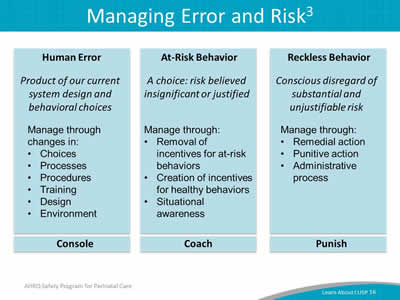
Say:
To improve outcomes, human error, at-risk behavior, and reckless behavior each should be managed appropriately.
Human error is a product of both system design and behavioral choices. Human error can be managed through changes in processes, procedures, training, system design, or work environment. The proper management approach is to console providers who have committed a human error and to ensure proper systems and procedures are in place to support future appropriate choices.
At-risk behavior is an active choice to engage in risky activity through a belief that the risk was either insignificant or justified for a particular outcome. The best approach to dealing with at-risk behavior is to remove any incentives for engaging in it and to verify the system encourages healthy, risk-reducing behaviors.
Reckless behavior is a conscious disregard of substantial and unjustifiable risk. When reckless behavior has occurred, it must be met with remedial or punitive action to decrease or eliminate the chances the behavior will reoccur.
Slide 17: Systems and Behaviors Work Together To Improve Outcomes
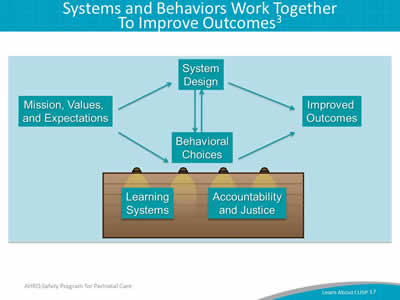
Say:
Within the Just Culture model, five elements contribute to improved outcomes:
- Mission, values, and expectations.
- System design.
- Behavioral choices.
- Learning systems.
- Accountability and justice.
Slide 18: Systems and Behaviors Work Together To Improve Outcomes
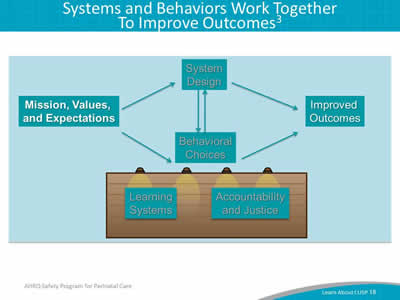
Say:
Mission, values, and expectations
For an organization to be effective in fulfilling its purpose, it must first define its mission and articulate values and expectations that align with that mission. Perfection is not a productive expectation because it is unattainable. Rather, an organization should set improvement as a goal.
Slide 19: Systems and Behaviors Work Together To Improve Outcomes
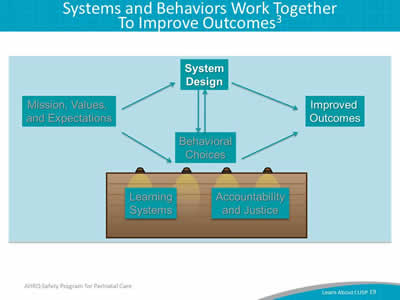
Say:
System design
Humans are fallible and occasionally make mistakes, either through inadvertent errors or risky behaviors. To achieve optimal outcomes, organizations must design robust systems that minimize risks. Forcing functions, checks, and redundancies are some features of systems intended to minimize the risk of error.
Slide 20: Systems and Behaviors Work Together To Improve Outcomes
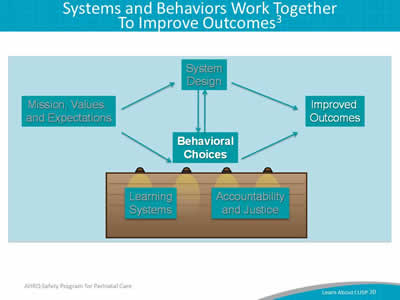
Say:
Behavioral choices
Managing human behavior is essential to refining outcomes. It is critical to reinforce behaviors that will reduce risk and deter behaviors that increase risk.
Slide 21: Systems and Behaviors Work Together To Improve Outcomes
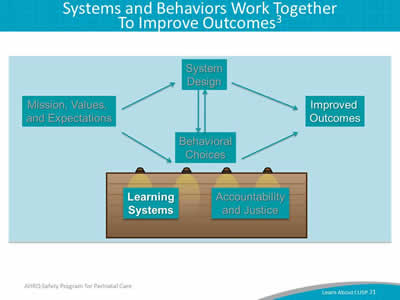
Say:
Learning systems
By establishing learning systems, organizations can manage both systems and human behavior. The Staff Safety Assessment and Learning From Defects tools in this perinatal CUSP toolkit are two communication tools that can be used to promote learning systems.
Slide 22: Systems and Behaviors Work Together To Improve Outcomes
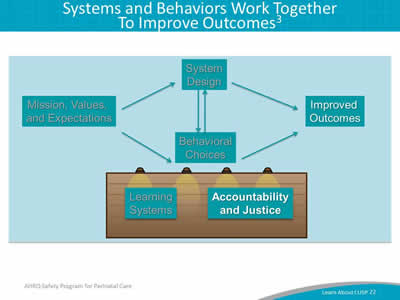
Say:
Accountability and justice
Accountability in a Just Culture environment is about more than simply blaming a person whenever a patient is harmed. In a Just Culture environment, the quality of behavioral choices should be emphasized more than the outcome of the choices, which may or may not have resulted in harm.
Slide 23: Engineering System Design To Support Behavior Choices
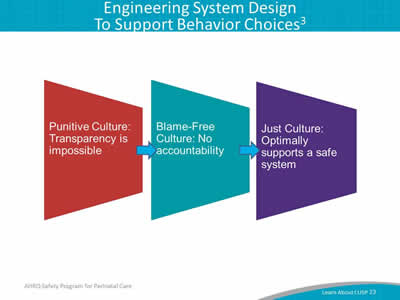
Say:
A Just Culture environment is ruled by both transparency and accountability. In a punitive culture that does not strive to understand potential underlying reasons for at-risk behaviors, transparency is impossible. This is especially problematic given that transparency and open communication are necessary for true cooperation, coordination, and teamwork to occur. Transparency is also vital in addressing system factors that may contribute to harm.
At the other extreme, a culture that does not hold team members accountable will never achieve optimal outcomes. In what has been known as a blame-free culture, there is a general failure to uphold standards of care, and staff members are less likely to hold themselves and one another accountable for appropriate behaviors. In contrast, a Just Culture environment will support improved outcomes by emphasizing both robust systems and appropriate behaviors.
Slide 24: Leadership Team's Role in Applying Just Culture Principles
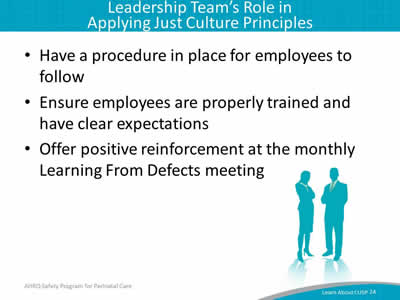
Say:
There are key ways L&D unit leaders can apply Just Culture principles to enhance culture, accountability, and safety on their unit.
First, L&D unit leaders can have procedures in place for employees to follow. Confirming that protocols are standardized and well communicated helps employees make the right choices, leading to the best outcomes. When designing procedures, be sure to eliminate reasons for at-risk behavior and reinforce incentives for healthy, risk-reducing choices.
Second, ensure employees are properly trained. Employees should know the correct procedures and grasp the underlying reasons for those procedures so they will be more inclined to engage in appropriate behaviors.
Third, offer positive reinforcement at the monthly Learning From Defects meeting. The Learning From Defects process is an effective way to instill or reinforce learning systems that contribute to improved results.
Slide 25: CUSP Is Compatible With TeamSTEPPS
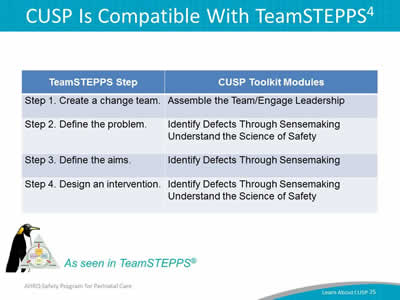
Say:
The CUSP Toolkit is compatible with TeamSTEPPS, and many of the templates and communication models in the toolkit are TeamSTEPPS tools. There are eight steps in the TeamSTEPPS model, the first four of which are—
Step 1: Create a change team.
Step 2: Define the problem.
Step 3: Define the aims, and
Step 4: Design an intervention.
Slide 26: CUSP is Compatible With TeamSTEPPS
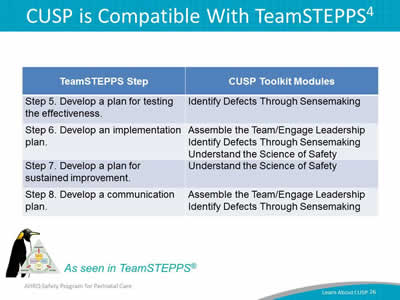
Say:
CUSP modules also help you carry out steps five through eight of TeamSTEPPS:
Step 5: Develop a plan for testing the effectiveness.
Step 6: Develop an implementation plan.
Step 7: Develop a plan for sustained improvement, and
Step 8: Develop a communication plan.
Slide 27: CUSP Results
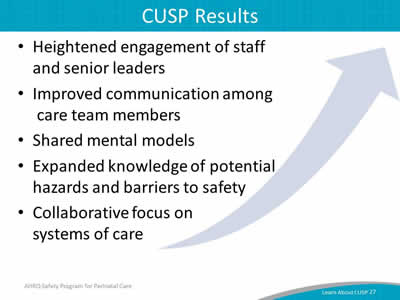
Say:
Culture change is hard work. As you complete the adaptive work of improving patient safety and confront challenges that will seem messy and intractable, keep your eyes on the prize and remember that in thousands of units all over the country, CUSP has brought measurable results. CUSP will help unit teams achieve—
- Heightened engagement of staff and senior leaders.
- Improved communication among care team members.
- Shared mental models.
- Expanded knowledge of potential hazards and barriers to safety.
- A collaborative focus on systems of care.
Slide 28: Summary
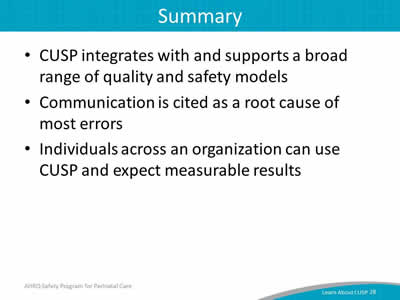
Say:
CUSP integrates with and supports a broad range of quality and safety improvement models. As units use CUSP and its tools, they should look at resources already in place and enhance the projects by combining them in efficient and effective ways.
People across an organization, and team members of any discipline or rank, can use the CUSP and expect measurable results.
Any implementation of CUSP will bring with it certain challenges. In confronting these challenges, often concentration on a specific module or tool will help overcome obstacles.
CUSP is an investment in time, energy, and dedication that brings both tangible and intangible benefits. When CUSP and SPPC tools become integrated into routine daily and weekly work flows, the process of improving safety will become a recognized complement to the process of care delivery itself. Implementation can lead to improved safety and improved staff satisfaction and retention.
Slide 29: References
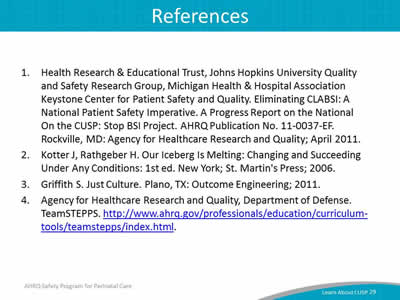
Slide 30: Disclaimers
